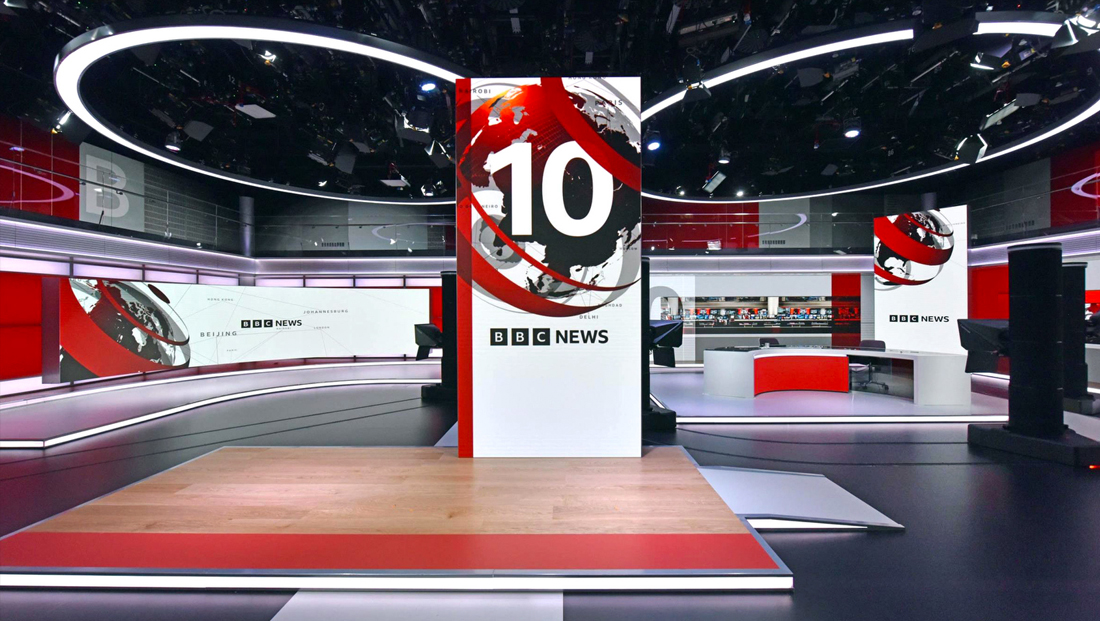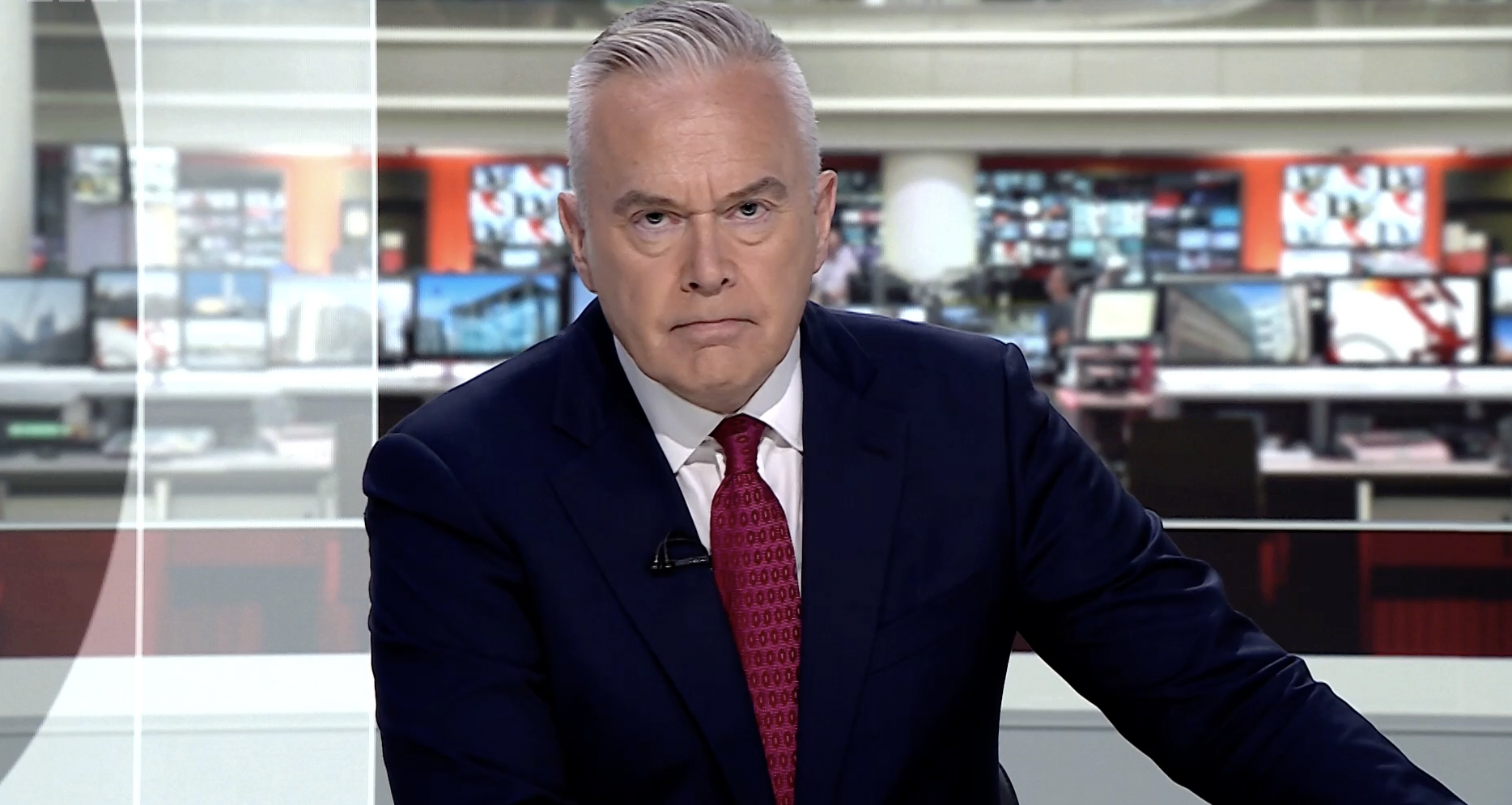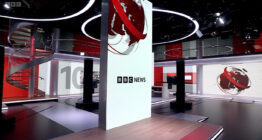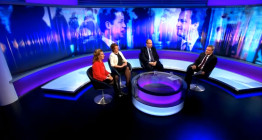BBC News Studio B gets new set after nearly a decade

Weekly insights on the technology, production and business decisions shaping media and broadcast. Free to access. Independent coverage. Unsubscribe anytime.
On June 13, 2022, the BBC debuted a new set inside Broadcasting House’s Studio B that builds upon the existing look while reimagining other elements.
The update is the first major change to take place in the new portion of Broadcasting House since its full opening about a decade ago, with the old set in Studio B and those in other spaces debuting around the time the building fully reopened in 2013 after a multiyear renovation and expansion.
Studio B has been designed as the “flagship” studio for BBC One news productions and will be the home of the 6 and 10 p.m. news as well as regional reports for London.
The content is produced by the BBC News division, which also operates BBC World News and the BBC News channel, originating primarily out of Studio E overlooking the complex’s massive, multistory newsroom, and Studio C.
Studio B as closed in 2020, reportedly as a cost-saving measure during the coronavirus pandemic, so it was able to undergo the new set installation quietly behind the scenes.
BBC Two’s “Newsnight,” which previously used Studio B with a darker lighting cue and a blue-violet shade in backlit panels, relocated to Studio 54D, which is also used by BBC Persian Television.
The original Studio B featured two distinct zones that were roughly wrapped in their own circular footprints and, like the new set, was designed by Simon Jago, a prolific scenic designer whose global portfolio includes work for U.K. rival Sky News.
The circular motif has been a key part of the BBC look for years — including on-air references to the iconic circular face of the clock that houses the bell Big Ben. London’s subway system, the Underground, also has a circular motif, and the two entities draw another visual connection thanks to similar typography. Although the BBC has since switched to its own bespoke font, the looks still share the same roots.
In addition, circles are used in the network’s graphics, which often feature radiating rings stemming from a globe, including in on-set graphics now used in Studio B and other BBC News productions.
The new Studio B set from Jago Design, however, is notable in that it leverages more 90-degree angles than the previous design while also expanding its footprint.
To be sure, there are still references to the circle — including two internally lit rings suspended above the studio that are a nod to the previous layout, as well as the large seamless LED video wall that stretches in front of one of the squared-off corners of the studio space.


On June 13’s broadcast, ‘BBC News at Ten’ introduced a new feature: When the national news wrapped and regional centers prepared to take over, an 18-box layout was shown behind the anchor. Each box showed the live feed of regional presenters standing by to deliver the news, most of them depicted sitting near a video panel with the branding of each center, such as ‘Look North’ or ‘Wales Today.’
Studio B’s curved video wall also serves as the backdrop for another trademark of BBC News sets — the catwalk.
Multiple BBC News studios boast a catwalk, typically a curved riser about one step above the primary floor placed in front of a trio of large built-in flatscreens often used to form a single image. These areas can, thanks to the careful layout, be used as either standup venues or as tosses to other areas of the studio from the presenter’s desk.

Studio B’s desk is another notable shift from the BBC’s other spaces. It goes from a circular module to a U-shaped one, a move that’s designed to allow more people in the studio to participate in debriefs, panels and other similar segments, while also being flexible enough to be shot with a single presenter.
Also no longer featured are the low, internally lit concentric rings that frequently surround BBC anchor desks.
This area features a rectangular riser and is placed in one corner of the set, though the intersection of two walls is partially hidden by one of two large “monolith” video towers set at an angle (this one is known as Tower B) that, like most of the primary LED, is a 2.5 mm product from Anna Valley.
Camera left of this area is a practical spiral staircase inspired by the ones flanking the newsroom upstairs, which frequently appear in the extended opening bumps the channel often shows at the top of news updates and programs.
To the left of this is that curved video wall installation and catwalk area. Combined, these two distinct zones are wrapped by a functional balcony back with 3.9 mm LED video walls on three sides that use right angles in either corner.

The new set also features two distinct spaces in the foreground. One is a freestanding monolith video tower, dubbed Tower A, with a riser featuring a design element that’s not commonly found on BBC sets — a wood finish. In keeping with the modern feel, however, the wood is a lighter shade.
BBC’s iconic red is still incorporated into the look — through both a floor finish found here as well as backlit panels behind the catwalk video wall and front of the anchor desk, the latter of which can be shifted to other colors as needed for special segments or programming.
Many of the other red references are shown on the video walls.


The background here is being shown on video wall and incorporates a video loop of the BBC newsroom, which in reality is located upstairs from Studio B. The design also includes a variety of red, gray and white overlays with varying transparency.
While the LED display technology obviously gives the flexibility to shift backgrounds with the click of a mouse, the primary 6 and 10 p.m. news look incorporates virtual set extensions behind the presenter’s desk area. These include a depiction of the newsroom visible through a wide but short opening on the graphics fed to the LED panels. There’s also a series of overlapping gray, white and red elements with varying transparency, as well as space for an oversized number presenting the broadcast’s time.
Camera right of this, opposite the video tower, is the option to include another gray, white and red virtual wall that appears to be sporting a row of smaller wall-mounted flat panels.
In addition to the tower, another foreground venue camera right of this includes a seamless LED video wall set between rounded columns that incorporates touchscreen technology.
BBC uses Vizrt to power its video walls.
During a tour of the new set posted on June 13, presenter Huw Edwards emphasized how the numerous video surfaces will help the broadcasts better tell stories, including demonstrations of how the curved video wall and catwalk are ideal for horizontal imagery while the central tower evokes the feeling of a mobile device and therefore reads best in the portrait orientation.

In addition to the scenic updates, BBC also installed a tracked robotic camera system from Electric Friends. The units feature the company’s trademark vertical columns but are outfitted with a full prompter system from Autoscript — rather than the typical application used with these robotics including a forward-facing, below the lens teleprompter (or autocue) screen above the lens of the PTZ camera.
The Electric Friends bases have the advantage of not requiring cables because the tracks are used to convey both electrical power and video signals to and from each unit. They also have significantly lower profile tracks than the Furio ones in Studio E.
Thanks to a vertical track inside of each column, cameras can be boomed up or down, while the tracks make trucking possible. The robotics inside of the column add the pan and tilt functions, while the camera’s zoom feature is tied into the remote and automation control systems.
Studio B’s tracks have been carefully aligned to allow all of the various venues and views to be captured and feature mostly straight legs of track that, in some cases, have a tight curve in the corner. Studios C and E both feature tracked robotic camera systems as well, though these are primarily confined to multiple circular paths around the anchor desk at the center of the studio, unlike those in Studio B.
There is also a track located in front of the set that can capture extreme wide views of the set, including showcasing the other units.
All of these systems are designed to allow BBC to use smooth on-air camera moves that combine trucking, booming and zooming simultaneously, resulting in trademark moving shots that start wide and gradually tighten up, becoming a more traditional one shot or framing anchors against, for example, a video panel for an OTS-style shot.
In addition, the rectangular tower profile of the Electric Friends units coordinate with the set’s 90-degree angles and, in particular, the LED towers, making them almost part of the set rather than equipment placed in the space when they appear on-air in wide shots.

June 13’s “News at Ten” was a well-produced affair that seemed designed to take full advantage of the new set, with wide video wall shots showcasing maps to cover Ukraine and the Northern Ireland Protocol. During Ukraine coverage, Edwards was on the catwalk and would turn and gesture toward the graphic behind him, while the trade story was done from the touchscreen.
There were some stories introduced from a simple one shot of Edwards in front of the virtual set extension’s view of the newsroom view loop and sans any supplementary video wall graphics.

Another option was to use the monolith in the corner of the anchor area as either an OTS element or toss to a remote reporter.


Other segments called for Edwards to get up in front of the desk and walk to another area of the studio, with a wide shot typically being used to showcase his transition. Weather, which included a cross shot to the desk, was done from the touchscreen area before Edwards got up and, in a single shot, walked over the catwalk to to tease “Newsnight” by dipping into the feed from that studio and then toss to regional centers.


The center video tower was used only in a wide view at the top of the broadcast and then to showcase the mobile version of the BBC website for a video-on-video shot promoting the site and the BBC app.
That graphic used the three-square animation that was introduced for the news division as part of a rebranding effort that included a new logo that debuted in October 2021.
BBC has not announced immediate plans to overhaul its other studios inside of new Broadcasting House, though it would appear they might be prime candidates for updates given most are now about a decade old and could be updated to incorporate some of the new design elements and technology.
Anna Valley provided and integrated the Studio B display technology with the screens driven by Vizrt tools.
In the control room, a new Grass Valley Kahuna 9600 switcher is also present.








tags
Anna Valley, Autoscript, BBC, BBC News, BBC One, Broadcasting House, Electric Friends, jago design, simon jago, studio b, studio e
categories
Heroes, International Set Design, News Set Design, Set Design